The Abyss
7.6 /10 1 Votes
89% Rotten Tomatoes Budget 69.5 million USD Duration Country United States | 7.6/10 IMDb 62% Metacritic Genre Adventure, Drama, Sci-Fi Writer James Cameron Language English | |||||||||||||||||||||||||||||||||
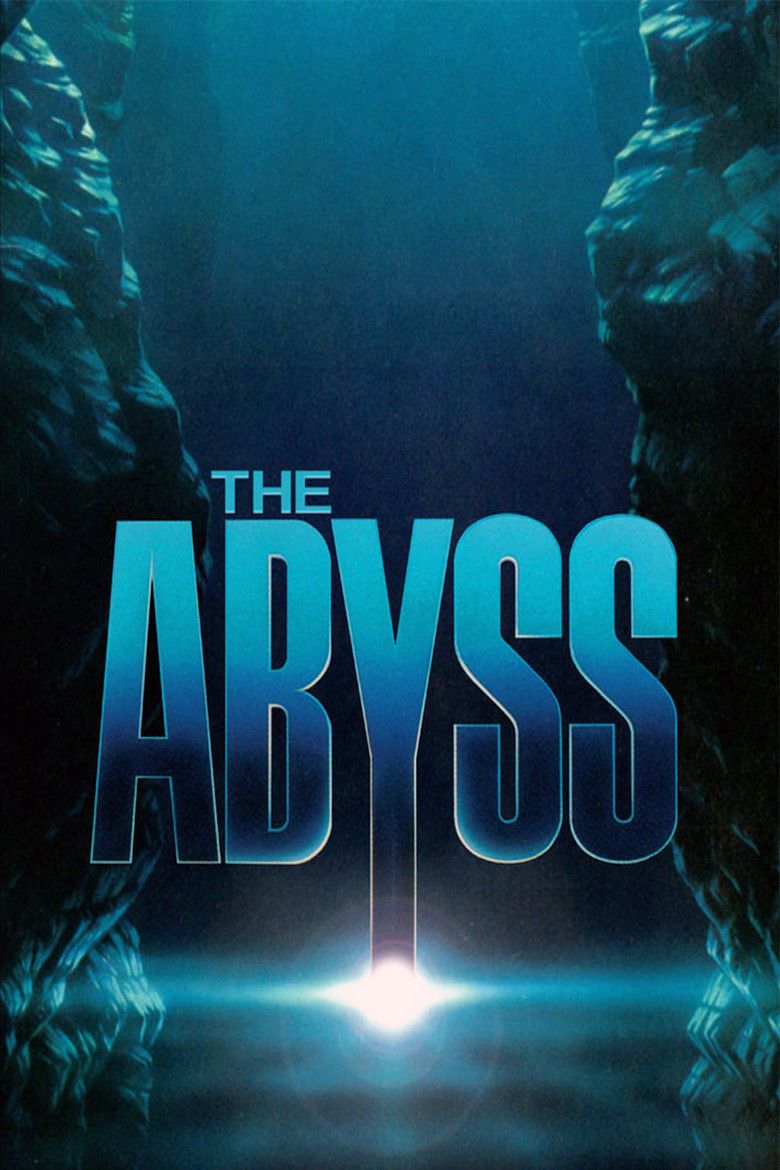 | ||||||||||||||||||||||||||||||||||
Release date August 9, 1989 (1989-08-09) Cast (Virgil 'Bud' Brigman), (Lindsey Brigman), (Lieutenant Hiram Coffey), (Catfish De Vries), (Alan 'Hippy' Carnes), (Jammer Willis) Similar movies Thunderball , Leviathan , E.T. the Extra-Terrestrial , DeepStar Six , 20,000 Leagues Under the Sea , The SpongeBob Movie: Sponge Out of Water Tagline There's everything you've ever known about adventure, and then there's The Abyss. | ||||||||||||||||||||||||||||||||||
The abyss 1989 trailer
The Abyss is a 1989 American science fiction film written and directed by Canadian director James Cameron, starring Ed Harris, Mary Elizabeth Mastrantonio, and Michael Biehn. When an American submarine sinks in the Caribbean, the U.S. search and recovery team works with an oil platform crew, racing against Russian vessels to recover the boat. Deep in the ocean, they encounter something unexpected. The film was released on August 9, 1989, and grossed $90 million. It won the Academy Award for Best Visual Effects and was nominated for three more Academy awards.
Contents
- The abyss 1989 trailer
- Plot
- Special Edition
- Cast
- Production
- Pre production
- Principal photography
- Post production
- Box office
- Critical response
- Accolades
- Soundtrack
- Deluxe Edition
- History of the Special Edition
- Adaptations
- References

Plot

In 1988, the U.S. Ohio-class submarine USS Montana has an encounter with an unidentified submerged object and sinks near the Cayman Trough. With Soviet ships moving in to try to salvage the sub and a hurricane moving over the area, the U.S. government opts to send a SEAL team to Deep Core, a privately owned experimental underwater drilling platform near the Cayman Trough to use as a base of operations. The platform's designer, Dr. Lindsey Brigman, insists on going along with the SEAL team, despite her estranged husband Virgil "Bud" Brigman being the current foreman.
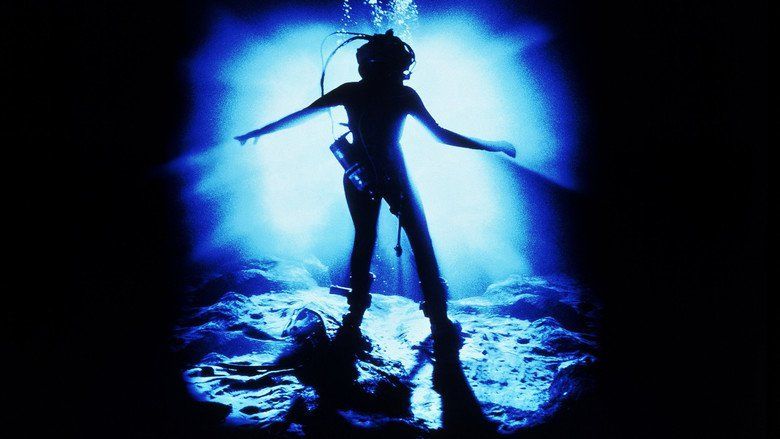
During initial investigation of the Montana, a power outage in the team's submersibles leads to Lindsey seeing a strange light circling the sub, which she later calls "non-terrestrial intelligence" or "NTI"s. Lt. Coffey, the SEAL team leader, is ordered to accelerate their mission and to take one of the mini-subs without Deep Core's permission and recover a Trident missile warhead from the Montana, just as the storm hits above. The Benthic Explorer, to which Deep Core is tethered, is rocked by the storm, and the cable crane is torn from the ship. The crane falls into the trench and, without the mini-sub to disconnect the cable, Deep Core is dragged toward the trench, stopping just short of it. The rig is partially flooded, killing several crew members and damaging its power systems. Coffey shows little remorse when he and his SEALs return to the damaged base.
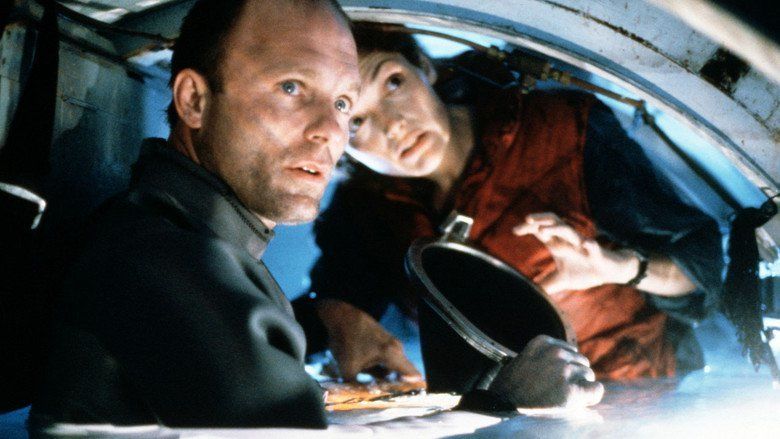
The crew wait out the storm so they can restore communications and be rescued. As the crew struggles against the cold, they find an NTI has formed an animated column of water and is exploring the base. Though they treat it with curiosity, Coffey is agitated by it and cuts it in half by closing a pressure bulkhead on it, causing it to retreat. The crew soon realize that Coffey is suffering paranoia from high-pressure nervous syndrome. Spying on him through a remote operated vehicle, they find he and another SEAL are arming the warhead to attack the NTIs, and race to stop him. Bud fights Coffey but Coffey escapes in a mini-sub with the primed warhead, and Bud and Lindsey give chase in the other sub. Coffey is able to launch the warhead into the trench, but his sub is damaged and drifts over the edge of the trough, and he is crushed when the sub implodes from high pressures. The other mini-sub is also damaged and is taking on water; with only one functional diving suit, Lindsey opts to enter deep hypothermia when the ocean's cold water engulfs her, and Bud swims back with her body to the platform. There, he and the crew administer CPR and revive her, and Bud and Lindsey reaffirm their lost love.

One SEAL, unaware of Coffey's plan at the time, helps to locate the warhead, stopped on a ledge several thousand feet down the trench. Bud volunteers to use an experimental diving suit equipped with a liquid breathing apparatus to survive to that depth, though he will only be able to communicate through a keypad on the suit. Bud begins his dive, assisted by Lindsey's voice keeping him coherent against the effects of the mounting pressure, and reaches the warhead. The SEAL guides him in successfully disarming it. With nearly no oxygen left in the system, Bud types out that he knew this was a one-way trip, and tells Lindsey he loves her. As he waits for death, an NTI approaches Bud and takes his hand. He is guided to an alien ship deeper in the trench. Deep inside, the NTI creates an atmospheric pocket for Bud, allowing him to breathe normally. The NTI plays back Bud's message to his wife, and the two look at each other with understanding.
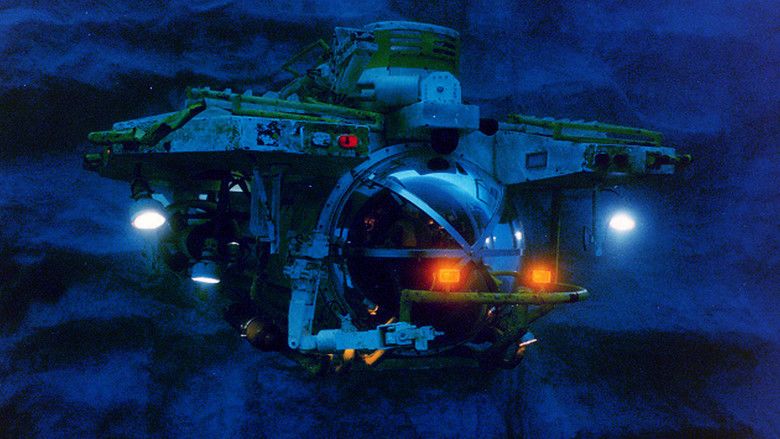
On Deep Core the crew is waiting for rescue when they see a message from Bud that he met some friends and warning them to hold on. The base shakes and lights from the trench bring the arrival of the alien ship. It rises to the ocean's surface, with Deep Core and several of the surface ships run aground on its hull. The crew of Deep Core leave the platform, surprised they are not suffering from decompression sickness, when they see Bud walking out of the alien ship, and Lindsey races to hug Bud.
Special Edition
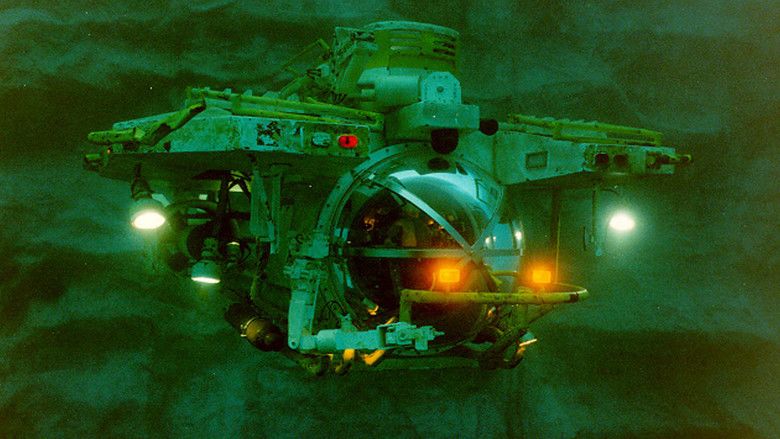
In the extended version, the events in the film are played against a backdrop of conflict between the United States and the Soviet Union, with the potential for all-out war; the sinking of the Montana additionally fuels the aggression. There is more conflict between Bud and Lindsey in regards to their former relationship. The primary addition is the ending: when Bud is taken to the alien ship, they start by showing him images of war and aggression from news sources around the globe. The aliens then create massive megatsunamis that threaten the world's coasts, but stop them short before they hit. They then show Bud his message to Lindsey, and let the megatsunamis disperse without damage, as a warning to humanity.
Cast
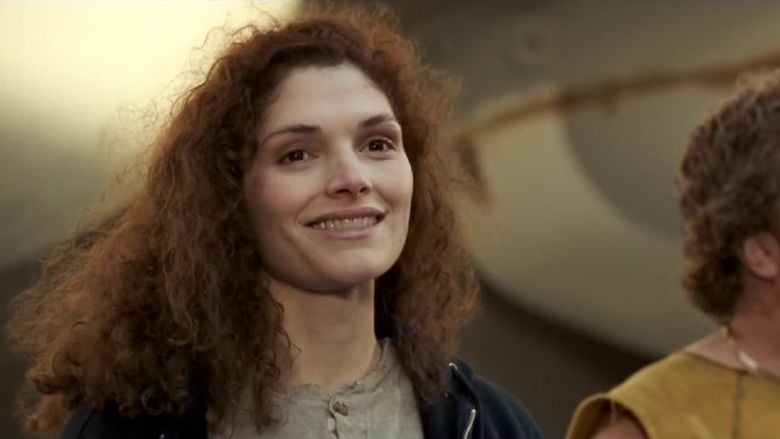
Production
H. G. Wells was the first to introduce the notion of a sea alien in his 1897 short story In the Abyss. The idea for The Abyss came to James Cameron when, at age 17 and in high school, he attended a science lecture about deep sea diving by a man, Francis J. Falejczyk, who was the first human to breathe fluid through his lungs in experiments conducted by Dr. Johannes A. Kylstra. He subsequently wrote a short story that focused on a group of scientists in a laboratory at the bottom of the ocean. The basic idea did not change, but many of the details evolved over the years. Once Cameron arrived in Hollywood, he quickly realized that a group of scientists was not that commercial and changed it to a group of blue-collar workers. While making Aliens, Cameron saw a National Geographic film about remote operated vehicles operating deep in the North Atlantic Ocean. These images reminded him of his short story. He and producer Gale Anne Hurd decided that The Abyss would be their next film. Cameron wrote a treatment combined with elements of a shooting script, which generated a lot of interest in Hollywood. He then wrote the script, basing the character of Lindsey on Hurd and finished it by the end of 1987. Cameron and Hurd were married before The Abyss, separated during pre-production, and divorced in February 1989, two months after principal photography.
Pre-production
The cast and crew trained for underwater diving for one week in the Cayman Islands. This was necessary because 40% of all live-action principal photography took place underwater. Furthermore, Cameron's production company had to design and build experimental equipment and develop a state-of-the-art communications system that allowed the director to talk underwater to the actors and dialogue to be recorded directly onto tape for the first time.
Cameron had originally planned to shoot on location in the Bahamas where the story was set but quickly realized that he needed to have a completely controlled environment because of the stunts and special visual effects involved. He considered shooting the film in Malta, which had the largest unfiltered tank of water, but it was not adequate for Cameron's needs. Underwater sequences for the film were shot at a unit of the Gaffney Studios, situated outside Gaffney, South Carolina, which had been abandoned by Duke Power officials after previously spending $700 million constructing the Cherokee Nuclear Power Plant, along Owensby Street, Gaffney, SC.
Two specially constructed tanks were used. The first one, based on the abandoned plant's primary reactor containment vessel, held 7.5 million US gallons (28,000 m3) of water, was 55 feet (18 m) deep and 209 feet (70 m) across. At the time, it was the largest fresh-water filtered tank in the world. Additional scenes were shot in the second tank, an unused turbine pit, which held 2.5 million US gallons (9,500 m3) of water. As the production crew rushed to finish painting the main tank, millions of gallons of water poured in and took five days to fill. The Deepcore rig was anchored to a 90-ton concrete column at the bottom of the large tank. It consisted of six partial and complete modules that took over half a year to plan and build from scratch.
Can-Dive Services Ltd., a Canadian commercial diving company that specialized in saturation diving systems and underwater technology, specially manufactured the two working craft (Flatbed and Cab One) for the film. Two million dollars was spent on set construction.
Filming was also done at the largest underground lake in the world — a mine in Bonne Terre, Missouri, which was the background for several underwater shots.
Principal photography
The main tank was not ready in time for the first day of principal photography. Cameron delayed filming for a week and pushed the smaller tank's schedule forward, demanding that it be ready weeks ahead of schedule. Filming eventually began on August 15, 1988, but there were still problems. On the first day of shooting in the main water tank, it sprang a leak and 150,000 US gallons (570 m3) of water a minute rushed out. The studio brought in dam-repair experts to seal it. In addition, enormous pipes with elbow fittings had been improperly installed. There was so much water pressure in them that the elbows blew off.
Cameron's choice of cinematographer on the movie was Mikael Salomon – a US-based Danish national who would go on to work on other blockbusters such as Backdraft and Arachnophobia before moving into the director's slot on a myriad of films and TV shows including two editions of the acclaimed HBO WW2 series Band of Brothers. Salomon used three cameras in watertight housings that were specially designed. Another special housing was designed for scenes that went from above-water dialogue to below-water dialogue. The filmmakers had to figure out how to keep the water clear enough to shoot and dark enough to look realistic at 2,000 feet (700 m), which was achieved by floating a thick layer of plastic beads in the water and covering the top of the tank with an enormous tarpaulin. Cameron wanted to see the actors' faces and hear their dialogue, and thus hired Western Space and Marine to engineer helmets which would remain optically clear underwater and installed state-of-the-art aircraft quality microphones into each helmet. Safety conditions were also a major factor with the installation of a decompression chamber on site, along with a diving bell and a safety diver for each actor.
The breathing fluid used in the film actually exists but has only been thoroughly investigated in animals. Over the previous 20 years it had been tested on several animals, who survived. The rat shown in the film was actually breathing fluid and survived unharmed, although the scene was censored in Britain for perceived cruelty to animals.
Ed Harris did not actually breathe the fluid. He held his breath inside a helmet full of liquid while being towed 30 feet (10 m) below the surface of the large tank. He recalled that the worst moments were being towed with fluid rushing up his nose and his eyes swelling up. Actors played their scenes at 33 feet (11 m), too shallow a depth for them to need decompression, and rarely stayed down for more than an hour at a time. Cameron and the 26-person underwater diving crew sank to 50 feet (17 m) and stayed down for five hours at a time. To avoid decompression sickness, they would have to hang from hoses halfway up the tank for as long as two hours, breathing pure oxygen.
The cast and crew endured over six months of grueling six-day, 70-hour weeks on an isolated set. At one point, Mary Elizabeth Mastrantonio had a physical and emotional breakdown on the set and on another occasion, Ed Harris burst into spontaneous sobbing while driving home. Cameron himself admitted, "I knew this was going to be a hard shoot, but even I had no idea just how hard. I don't ever want to go through this again". For example, for the scene where portions of the rig are flooded with water, he realized that he initially did not know how to minimize the sequence's inherent danger. It took him more than four hours to set up the shot safely. Actor Leo Burmester said, "Shooting The Abyss has been the hardest thing I've ever done. Jim Cameron is the type of director who pushes you to the edge, but he doesn't make you do anything he wouldn't do himself." A lightning storm caused a 200-foot (65 m) tear in the black tarpaulin covering the main tank. Repairing it would have taken too much time, so the production began shooting at night. In addition, blooming algae often reduced visibility to 20 feet (6 m) within hours. Over-chlorination led to divers' skin burning and exposed hair being stripped off or turning white.
As production went on, the slow pace and daily mental and physical strain of filming began to wear on the cast and crew. Mary Elizabeth Mastrantonio remembered, "We never started and finished any one scene in any one day". At one point, Cameron told the actors to relieve themselves in their wetsuits to save time between takes. While filming one of many takes of Mastrantonio's character's resuscitation scene- in which she was soaking wet, topless and repeatedly being slapped and pounded on the chest- the camera ran out of film, prompting Mastrantonio to storm off the set yelling, "We are not animals!" For some shots in the scene that focus on Ed Harris, he was yelling at thin air because Mastrantonio refused to film the scene again. Michael Biehn also grew frustrated by the waiting. He claimed that he was in South Carolina for five months and only acted for three to four weeks. He remembered one day being ten meters underwater and "suddenly the lights went out. It was so black I couldn't see my hand. I couldn't surface. I realized I might not get out of there." Harris recalled: "One day we were all in our dressing rooms and people began throwing couches out the windows and smashing the walls. We just had to get our frustrations out." Cameron responded to these complaints, saying, "For every hour they spent trying to figure out what magazine to read, we spent an hour at the bottom of the tank breathing compressed air." After 140 days and $4 million over budget, filming finally wrapped on December 8, 1988. Before the film's release, there were reports from South Carolina that Ed Harris was so upset by the physical demands of the film and Cameron's dictatorial directing style that he said he would refuse to help promote the motion picture. Harris later denied this rumor and helped promote the film. But after its release and initial promotion, Harris publicly refused to ever again discuss the film, saying "I'm never talking about it and never will." Mary Elizabeth Mastrantonio has also since brushed off the film, commenting, "The Abyss was a lot of things. Fun to make is not one of them."
Post-production
To create the alien water tentacle, Cameron initially considered cel animation or a tentacle sculpted in clay and then animated via stop-motion techniques with water reflections projected onto it. Phil Tippett suggested Cameron contact Industrial Light & Magic. The special visual effects work was divided up among seven FX divisions with motion control work by Dream Quest Images and computer graphics and opticals by ILM. ILM designed a program to produce surface waves of differing sizes and kinetic properties for the pseudopod. For the moment where it mimics Bud and Lindsey's faces, Ed Harris had eight of his facial expressions scanned while twelve of Mastrantonio's were scanned via software used to create computer-generated sculptures. The set was photographed from every angle and digitally recreated so that the pseudopod could be accurately composited into the live-action footage. The company spent six months to create 75 seconds of computer graphics needed for the creature. The film was to have opened on July 4, 1989, but its release was delayed for more than a month by production and special effects problems. The animated sequences were supervised by ILM animation director Wes Takahashi.
Studio executives were nervous about the film's commercial prospects when preview audiences laughed at scenes of serious intent. Industry insiders said that the release delay was because nervous executives ordered the film's ending completely re-shot. There was also the question of the size of the film's budget: 20th Century Fox stated that the budget was $43 million, a figure Cameron himself has reiterated. However, estimates put the figure higher with The New York Times estimating the cost at $45 million and one executive claiming it cost $47 million, while box office revenue tracker website The Numbers lists the production budget at $70 million.
Box office
The Abyss was released on August 9, 1989, in 1,533 theaters, where it grossed $9.3 million on its opening weekend and ranked #2 at the box office. It went on to make $54.5 million in North America and $35.5 million throughout the rest of the world for a worldwide total of $90 million.
Critical response
On Rotten Tomatoes, a review aggregator, The Abyss has an 89% approval rating based on 44 reviews and an average rating of 7.2 out of 10. The critical consensus states: "The utterly gorgeous special effects frequently overshadow the fact that The Abyss is also a totally gripping, claustrophobic thriller, complete with an interesting crew of characters." On Metacritic, the film has an average score of 62 out of 100, based on 14 critics indicating "generally favorable reviews". The reviews tallied therein are for both the theatrical release and the Special Edition.
Newsweek magazine's David Ansen, summarizing the theatrical release, wrote, "The payoff to The Abyss is pretty damn silly — a portentous deus ex machina that leaves too many questions unanswered and evokes too many other films." In her review for The New York Times, Caryn James claimed that the film had "at least four endings," and "by the time the last ending of this two-and-a-quarter-hour film comes along, the effect is like getting off a demon roller coaster that has kept racing several laps after you were ready to get off." Chris Dafoe, in his review for The Globe and Mail, wrote, "At its best, The Abyss offers a harrowing, thrilling journey through inky waters and high tension. In the end, however, this torpedo turns out to be a dud - it swerves at the last minute, missing its target and exploding ineffectually in a flash of fantasy and fairy-tale schtick."
While praising the film's first two hours as "compelling", the Toronto Star remarked, "But when Cameron takes the adventure to the next step, deep into the heart of fantasy, it all becomes one great big deja boo. If we are to believe what Cameron finds way down there, E.T. didn't really phone home, he went surfing and fell off his board." USA Today gave the film three out of four stars and wrote, "Most of this underwater blockbuster is 'good,' and at least two action set pieces are great. But the dopey wrap-up sinks the rest 20,000 leagues." In her review for The Washington Post, Rita Kempley wrote that the film "asks us to believe that the drowned return to life, that the comatose come to the rescue, that driven women become doting wives, that Neptune cares about landlubbers. I'd sooner believe that Moby Dick could swim up the drainpipe." Halliwell's Film Guide claimed the film was "despite some clever special effects, a tedious, overlong fantasy that is more excited by machinery than people." Conversely, Rolling Stone magazine's Peter Travers enthused, "[The Abyss is] the greatest underwater adventure ever filmed, the most consistently enthralling of the summer blockbusters...one of the best pictures of the year."
The release of the Special Edition in 1993 garnered much praise. Each giving it thumbs up, Siskel remarked, "The Abyss has been improved," and Ebert added, "It makes the film seem more well rounded." In the book Reel Views 2, James Berardinelli comments, "James Cameron's The Abyss may be the most extreme example of an available movie that demonstrates how the vision of a director, once fully realized on screen, can transform a good motion picture into a great one."
Accolades
The Abyss won the 1990 Oscar for Best Visual Effects (John Bruno, Dennis Muren, Hoyt Yeatman, and Dennis Skotak). It was also nominated for:
The studio unsuccessfully lobbied hard to get Michael Biehn nominated for the Academy Award for Best Supporting Actor.
Many other film organizations, such as the Academy of Science Fiction, Fantasy & Horror Films and the American Society of Cinematographers, also nominated The Abyss. The film ended up winning a total of three other awards from these organizations.
Soundtrack
The soundtrack to The Abyss was released on August 22, 1989.
Deluxe Edition
Varese Sarabande, which released the original album, issued a limited edition (3000 copies) two-disc album in 2014 featuring the complete score.
Disc One:
- Opening Title (:42)
- Montana / Crash / Flood (2:01)
- Marker Buoy / They’re Coming (1:17)
- Let Me Drown Your Rat / Search The Montana (10:09)
- Jammer Freaks (3:30)
- He’s Convulsing (1:14)
- MIRV Recovery / SEALs Return (2:03)
- Crashing Crane (2:08)
- What A Drag (2:01)
- The Draggiest Man (1:22)
- Lindsey’s Close Encounter (6:23)
- Here’s MIRV / Some Huevos (2:27)
- Have To Take Steps / Jarhead Is Watching (1:13)
- The Pseudopod (5:35)
- Coffey Break (1:56)
- Freeze (3:40)
- Bud And Cat Dive / Click (:59)
- The Fight (1:52)
- What A Drag (Original) (6:05)
Disc Two: Tracks 10-19 are bonus tracks.
- Coffey Implodes (1:09)
- The Only Way (7:49)
- Resurrection (2:00)
- Bud’s Big Dive (6:40)
- Defusing The Bomb (2:17)
- Bud On The Ledge (3:12)
- Bud Reborn / Blinky Bows (3:22)
- Back On The Air (1:47)
- Finale And End Credits (4:47)
- Opening Title (Demo) (:43)
- Flood And Sinking (Alternate) / Unused Synth Cue (1:01)
- Crashing Crane (Alternate) (2:08)
- What A Drag (Wild Original) (4:33)
- Some Huevos (Alternate) (1:19)
- The Pseudopod (Alternate) (5:33)
- The Fight (Alternate) (1:51)
- The Only Way (Alternate) (4:54)
- Lindsey Dies (Alternate) (1:05)
- Vocal Insert (:56)
History of the Special Edition
Even as the film was in the first weeks of its 1989 theatrical release, rumors were circulating of a wave sequence missing from the film's end. As chronicled in the 1993 laserdisc Special Edition release and later in the 2000 DVD, the pressure to cut the film's running time stemmed from both distribution concerns and Industrial Light & Magic's then-inability to complete the required sequences. From the distributor's perspective, the looming three-hour length limited the number of times the film could be shown each day, assuming that audiences would be willing to sit through the entire film, though 1990's Dances with Wolves would shatter both industry-held notions. Further, test audience screenings revealed a surprisingly mixed reaction to the sequences as they appeared in their unfinished form; in post-screening surveys, they dominated both the "Scenes I liked most" and "Scenes I liked least" fields. Contrary to speculation, studio meddling was not the cause of the shortened length; Cameron held final cut as long as the film met a running time of roughly two hours and 15 minutes. He later noted, "Ironically, the studio brass were horrified when I said I was cutting the wave."
What emerges in the winnowing process is only the best stuff. And I think the overall caliber of the film is improved by that. I cut only two minutes of Terminator. On Aliens, we took out much more. I even reconstituted some of that in a special (TV) release version. The sense of something being missing on Aliens was greater for me than on The Abyss, where the film just got consistently better as the cut got along. The film must function as a dramatic, organic whole. When I cut the film together, things that read well on paper, on a conceptual level, didn't necessarily translate to the screen as well. I felt I was losing something by breaking my focus. Breaking the story's focus and coming off the main characters was a far greater detriment to the film than what was gained. The film keeps the same message intact at a thematic level, not at a really overt level, by working in a symbolic way.
Cameron elected to remove the sequences along with other, shorter scenes elsewhere in the film, reducing the running time from roughly two hours and 50 minutes to two hours and 20 minutes and diminishing his signature themes of nuclear peril and disarmament. Subsequent test audience screenings drew substantially better reactions.
Star Mary Elizabeth Mastrantonio publicly expressed regret about some of the scenes selected for removal from the film's theatrical cut: "There were some beautiful scenes that were taken out. I just wish we hadn't shot so much that isn't in the film."
Shortly after the film's premiere, Cameron and video editor Ed Marsh created a longer video cut of The Abyss for their own use that incorporated dailies. With the tremendous success of Cameron's Terminator 2: Judgment Day in 1991, Lightstorm Entertainment secured a five-year, $500 million financing deal with 20th Century Fox for films produced, directed or written by Cameron. The contract allocated roughly $500,000 of the amount to complete The Abyss. ILM was commissioned to finish the work they had started three years earlier, with many of the same people who had worked on it originally.
The CGI tools developed for Terminator 2: Judgment Day allowed ILM to complete the rumored tidal-wave sequence, as well as correcting flaws in rendering for all their other work done for the film.
The tidal wave sequence had originally been designed by ILM as a physical effect, using a plastic wave, but Cameron was dissatisfied with the end result, and the sequence was scrapped. By the time Cameron was ready to revisit The Abyss, ILM's CGI prowess had finally progressed to an appropriate level, and the wave was rendered as a CGI effect. Terminator 2: Judgment Day screenwriter and frequent Cameron collaborator William Wisher had a cameo in the scene as a reporter in Santa Monica who catches the first tidal wave on camera.
When it was discovered that original production sound recordings had been lost, new dialogue and foley were recorded, but since Captain Kidd Brewer had died of a self-inflicted gunshot before he could return to re-loop his dialog, producers and editors had to lift his original dialogue tracks from the remaining optical-sound prints of the dailies. The Special Edition was therefore dedicated to his memory as a result.
As Alan Silvestri was not available to compose new music for the restored scenes, Robert Garrett, who had composed temporary music for the film's initial cutting in 1989, was chosen to create new music. The Special Edition was completed in December 1992, with 28 minutes added to the film, and saw a limited theatrical release in New York City and Los Angeles on February 26, 1993, and expanded to key cities nationwide in the following weeks.
On home video, in addition to the conventional two-tape VHS release, the first THX-certified LaserDisc title of the Special Edition Box Set was released in May 1993 and was a best seller for the rest of the year. Both the theatrical and SE editions remain available on DVD; however all available DVDs are non-anamorphic, with the exception of the Chinese DVD produced for Region 6 by Excel Media.
While promoting the upcoming 30th anniversary Blu-ray release of Aliens at Comic-Con in San Diego July 2016 James Cameron has confirmed that he is working on a remastered 4K transfer of The Abyss and it will be released on Blu-ray for the first time in early 2017.
Cameron added, "We've done a wet-gate 4K scan of the original negative, and it's going to look insanely good. We're going to do an authoring pass in the DI for Blu-ray and HDR at the same time"
It's unknown whether both the Theatrical and Special Edition will be included.
Adaptations
Science-fiction author Orson Scott Card was hired to write a novelization of the film based on the screenplay and discussions with Cameron. He wrote back-stories for Bud, Lindsey and Coffey as a means not only of helping the actors define their roles, but also to justify some of their behavior and mannerisms in the film. Card also wrote the aliens as a colonizing species which preferentially sought high-pressure deep-water worlds to build their ships as they traveled further into the galaxy (their mothership was in orbit on the far side of the moon). The NTIs' knowledge of neuroanatomy and nanoscale manipulation of biochemistry was responsible for many of the deus ex machina aspects of the film.
A licensed interactive fiction video game based on the script was being developed for Infocom by Bob Bates, but was cancelled when Infocom was shut down by its then-parent company Activision. Sound Source Interactive later created an action video game entitled The Abyss: Incident at Europa. The game takes place a few years after the film, where the player must find a cure for a deadly virus.
References
The Abyss WikipediaThe Abyss IMDbThe Abyss Rotten TomatoesThe Abyss MetacriticThe Abyss themoviedb.org
